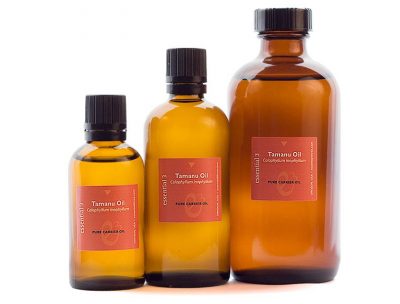No products in the cart.
from $19.40
Email to a friendDescription
Latin name: Calophyllum inophyllum
Extraction method: Cold pressed, unrefined
Storage: Keep refrigerated – Use within one year
(Please note: Refrigeration can help to to extend the life of all carrier oils)
Why Use
Tamanu can be used alone or blended with other carrier oils. It is useful for insect bites, minor burns, small cuts, blisters, and scrapes. It is helpful for nerve pain conditions such as neuralgia, shingles, and sciatica. It also makes an excellent facial oil to smooth and soften the complexion.
The Calophyllum inophyllum tree grows plentifully in the coastal regions of the South Pacific. (Its name means ‘beautiful leaf.’) When its spherical fruit drop from the tree, they are collected and cracked open. The kernel is removed and laid in the sun to dry. Over time, the kernels turn a deep-brown color and secrete a thick, rich, fragrant oil, which is cold-pressed from the kernel and is known as Tamanu oil. Tamanu has been researched since the 1930s and has been used in hospitals for its wound-healing capabilities in Europe, Asia, and the Pacific islands. It fights bacteria, reduces inflammation, and promotes the formation of new tissue. These capabilities are attributed to its unique content of lipids (neutral lipids, glycolipids, and phospholipids), calophyllic acid (a fatty acid), and calophyllolide (an anti-bacterial and non-steroidal anti-inflammatory).
(E3 sells only unrefined Tamanu, which is deeper in color, thicker, and richer in aroma and beneficial constituents than refined.
Staff Note: “Although higher in price than some other carrier oils, this is a superb oil to add to skincare blends or to use directly as a region application. A little goes a long way with this oil. I consider this to be one of my “must-have oils” in my first aid and skincare kits.” Lakita Certified Aromatherapist
Carrier oils are also known as base oils, massage oils, and fixed oils. They are extracted from various types and parts of plants, including the nuts, seeds, leaves, and flowers.
Carrier oils are used in aromatherapy to dilute essential oils to a level that is safe to use on the skin. They mainly consist of fatty acids or lipids. These fatty acids have therapeutic properties that add additional benefits to an essential oil blend.
When combining essential oils with carrier oils, follow the instruction leaflet included with each essential oil, paying attention to the safety guidelines. As with essential oils, carrier oils can be blended together to create a synergy. For example, to make a rich massage oil for dry skin, add some jojoba oil to sweet almond oil. For mature skin, add some rosehip seed oil.
At Essential 3, we select what we believe to be the best carrier oils. Whenever possible, we use unrefined versions of the oils as they contain more natural constituents, including vitamins and other beneficial ingredients.


